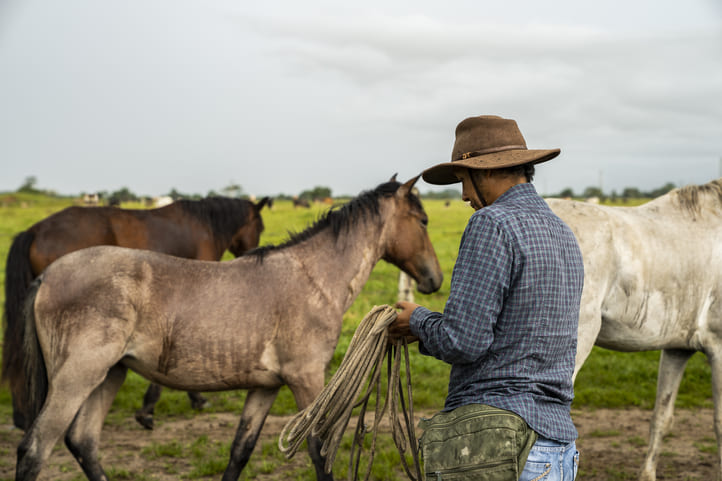Updated on 03/15/2024
Dear Esteemed Readers,
Greetings from Pelecanus, your Bogota Travel Operator! We take immense pleasure in offering our expertise to curate a personalized Colombian holiday experience tailored just for you.
At the end of this guide, you will find a list of many other helpful Colombia travel guides.
Content
Introduction to the Eastern Plains of Colombia
The Llanos in Colombia is an expansive region that combines natural beauty with a rich cultural heritage. Travelers and enthusiasts need to understand its geographical dimensions, climate, and infrastructure to fully appreciate its significance.
Geographical Dimensions and Political Divisions of Los Llanos
- Size: Los Llanos in Colombia, an extensive tropical grassland, covers an immense area that is often compared to the size of larger European countries. Spanning several departments including Meta, Casanare, Arauca, and parts of Vichada, its size is formidable. For context, the entire region of Los Llanos, which also extends into Venezuela, is roughly comparable in size to the entire nation of Germany. This vast expanse underscores the ecological and geographical significance of the area. Within Colombia, Los Llanos is a vast swathe of land, demonstrating a striking contrast to the country’s mountainous regions and dense rainforests. This sheer size contributes to its diverse ecosystems, ranging from savannas to riverine forests, making it a vital area for biodiversity and ecological research.
- Departments: It spans several Colombian departments, including Meta, Casanare, Arauca, and parts of Vichada.
- Capitals and Major Cities: Villavicencio in Meta is a major city and often considered the gateway to the Llanos. Other important cities include Yopal in Casanare and Arauca in the department of the same name.
Climate and Weather in Los Llanos
- Tropical Climate: The Llanos experiences a tropical climate, characterized by a wet and a dry season.
- Temperature Range: Average temperatures range from 24°C to 28°C (75°F to 82°F), though they can vary.
- Rainfall: Los Llanos in Colombia experiences a distinct pattern of rainfall due to its tropical climate, characterized by a marked wet and dry season. Annually, the region receives substantial rainfall, typically ranging between 1,000 to 4,000 millimeters (39 to 157 inches), with variations depending on specific locations within the plains. The wet season, occurring roughly between April and November, sees the majority of this precipitation. During these months, some areas of Los Llanos can experience intense rainfall, leading to significant changes in the landscape, such as flooding in low-lying areas and a transformation of the savannas into vast wetlands. This seasonal rainfall is crucial for maintaining the unique ecosystems of Los Llanos, supporting its diverse flora and fauna, and sustaining the agricultural practices of the region.
- Best time to visit: Dry Season (December to March): Ideal for wildlife viewing and outdoor activities, as the reduced rainfall makes remote areas more accessible.
Infrastructure in Los Llanos
- Transportation: The infrastructure includes road networks connecting major cities and towns. Air travel is facilitated through airports like the Vanguardia Airport in Villavicencio. During the rainy season, when many areas are flooded, transport is sometimes only possible by plane.
- Accommodations and Facilities: For travelers, there are various accommodations ranging from hotels to eco-lodges, especially in and around major cities.
Ecological and Cultural Highlights in Los Llanos
- Biodiversity: The Llanos is home to a diverse range of flora and fauna, making it a haven for wildlife enthusiasts.
- Cultural Significance: The region has a rich cultural heritage, with music, dance, and festivals playing a significant role in the local lifestyle.
Historical Data of Los Llanos
- Pre-Colonial Era (Before 16th Century): Before European contact, Los Llanos was home to indigenous groups such as the Guahibo and Sáliva. These communities adapted to the region’s ecological challenges, living in harmony with the vast grasslands and rivers.
- Spanish Colonization (16th Century): With the arrival of Spanish explorers in the 1500s, the region witnessed significant cultural and economic changes. The Spanish introduced cattle ranching, which became a dominant economic activity and led to the gradual displacement and assimilation of indigenous populations.
- Development of the Llanero Culture (17th – 19th Century): Over the centuries, the practice of cattle ranching gave birth to the Llanero culture, characterized by skilled horsemen and cattle herders. This period saw the emergence of a distinct cultural identity that is emblematic of Los Llanos.
- Modernization and Economic Shifts (20th Century): The 1900s marked a period of significant change for Los Llanos, with the discovery of oil reserves and the expansion of agricultural activities, notably the cultivation of rice and oil palm. These developments brought new economic opportunities and challenges to the region.
- Contemporary Era (21st Century): Today, Los Llanos balances its rich cultural heritage with modern economic pursuits. While oil and agriculture remain important, there is a growing emphasis on preserving the region’s biodiversity and promoting sustainable practices.
Activities and Tourist Attractions in Casanare
Casanare, a department in the heart of Colombia’s Los Llanos region, offers a wide range of activities and attractions, rich in natural beauty and cultural heritage. Here’s a structured guide to explore the best of Casanare.
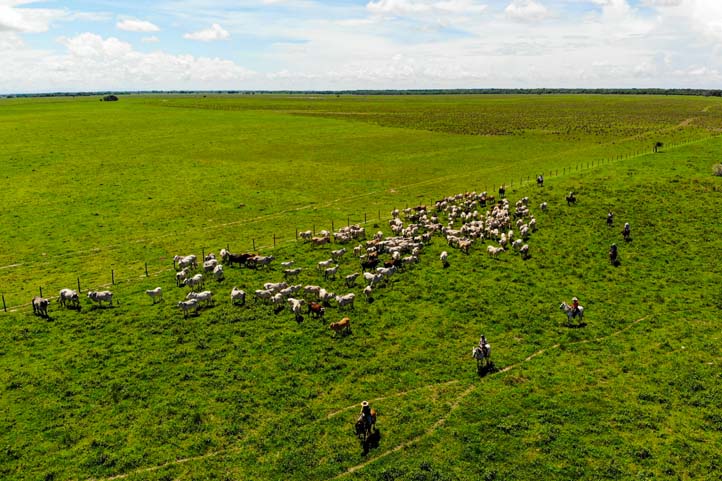
Getting to Yopal in Casanare
- By Air: The most convenient way to reach Casanare is to fly into El Alcaraván Airport in Yopal, with regular flights from Bogotá and other major cities.
- By Road: For those who prefer a scenic journey, driving to Casanare from major cities like Bogotá is an option. The journey offers picturesque views of the Colombian landscape.
Yopal: The Gateway to Casanare
Yopal, as the capital city of Casanare, serves not only as a gateway to the vast plains of Los Llanos but also as a hub of urban and cultural experiences. Here’s a more detailed look at what Yopal offers to its visitors.
Urban Exploration and Cultural Sites
- Local Markets and Regional Cuisine:
- Mamona: No visit to Yopal is complete without trying ‘Mamona’, the local term for a traditional barbecue. This culinary experience is unique to the Llanero culture, offering a taste of tender beef cooked over an open flame, often accompanied by yucca and other regional sides.
- Mercado Municipal: The bustling local market is a great place to experience the daily life of Yopal’s residents, offering everything from fresh produce to artisanal goods.
- Shopping and Local Crafts:
- Cowboy Hats and Attire: Reflecting its rich Llanero culture, Yopal is an ideal place to purchase authentic cowboy hats and other traditional attire. Several local shops and markets offer a range of handcrafted leather goods, perfect for souvenirs or personal use.
- Artisanal Crafts: For those interested in local handicrafts, Yopal has several stores selling items made by local artisans, including beautifully woven hammocks, handmade jewelry, and pottery.
- Cultural Centers and Museums:
- Yopal boasts several cultural centers and museums that showcase the history and art of the region. These institutions offer a deep dive into the local culture, traditions, and the Llanero way of life.
- Virgin Yopal (Virgen de Yopal):
- This hilltop monument is not only a spiritual landmark but also provides a breathtaking panoramic view of Yopal and the surrounding plains. The hike or drive to the top is rewarded with picturesque scenery.
- Thematic Stone Park:
- Situated near Yopal, this unique park features an impressive collection of stones, each telling a story about the region’s geological and cultural past. It’s an educational and visually intriguing attraction for visitors of all ages.
Get to learn more insights in our Yopal Colombia Travel Guide.
Natural Wonders and Outdoor Activities in Casanare
Casanare’s vast plains and rich biodiversity offer numerous natural wonders and outdoor activities. Below is a detailed guide on some of these attractions and how to access them from Yopal.
El Encanto de Guanapalo
- Location and Access: Located approximately 150 kilometers southeast of Yopal, El Encanto de Guanapalo can be reached by car in about 3-4 hours, depending on road conditions.
- Highlights: This area is known for its spectacular landscapes and diverse wildlife. It’s a prime location for birdwatching, with opportunities to see species like the Scarlet Ibis and Hoatzin. Nature trails and guided tours offer a deeper exploration of the area’s natural beauty.
- Activities: Wildlife safaris, horseback riding, and photographic tours are popular activities here, giving visitors a chance to immerse themselves in the serene and untouched landscapes of Los Llanos.
Altagracia
- Location and Access: Altagracia is roughly a 8-hour drive from Yopal.
- Highlights: This region is celebrated for its rich biodiversity. It’s a haven for bird enthusiasts, with a wide array of bird species thriving in its ecosystems.
- Activities: Bird watching is the main attraction, but the area also offers peaceful walks and the opportunity to enjoy the tranquil beauty of the Llanos’ grasslands and riverine forests.
Hato La Aurora
- Location and Access: Located about 250 kilometers northeast of Yopal, accessible by a 5-6 hour drive.
- Highlights: This vast estate is a prime example of conservation efforts in the Llanos. It’s known for its spectacular wildlife, including capybaras, anacondas, and a variety of bird species.
- Activities: Guided wildlife safaris, bird watching, and photography. Staying at Hato La Aurora offers an immersive experience into the wildlife and natural scenery of the region.
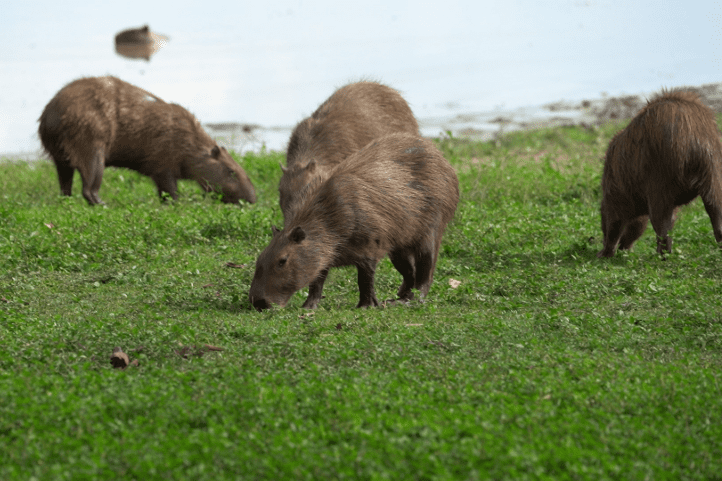
Ranch Experiences
- Location and Access: Various ranches (hatos) are scattered around Casanare, most within a 2-5 hour drive from Yopal.
- Hato Adventures: Places like Finca La Fortuna, Hato Los Deseos, Hato Berlin, and Hato San Pablo are accessible by road from Yopal. These ranches provide a mix of wildlife viewing, cultural experiences, and a glimpse into the life of the Llanero people.
- Activities: At these hatos, guests can engage in activities such as horseback riding, birdwatching, and guided wildlife safaris. These experiences are designed to showcase the natural environment and the traditional practices of the region.
Additional Attractions
- Fishing and River Expeditions: The rivers of Casanare offer opportunities for fishing and river tours, providing a unique way to explore the aquatic ecosystems of the region.
- Nature Photography: The landscape of Casanare, with its vast plains and diverse wildlife, is a paradise for photographers.
Cultural Immersion and Historical Sites in Casanare
Casanare’s rich cultural heritage and historical significance offer a variety of immersive experiences for visitors. Here’s a guide to some of the key cultural and historical attractions in the region, with details on how to access them from Yopal.
Local Towns and Historical Insights
- Tamara and Nuchia
- Location and Access: Both towns are within a 1-2 hour drive from Yopal.
- Highlights: These towns are quintessential examples of the rural and traditional lifestyle in Casanare. They offer a glimpse into the region’s history, local customs, and the Llanero culture.
- Activities: Visitors can enjoy traditional music and dance, local crafts, and experience the warm hospitality of the town’s residents.
- Trinidad
- Location and Access: Trinidad is approximately a 2-hour drive from Yopal.
- Highlights: Known for its rich Llanero culture, Trinidad is a hub for traditional music, dance, and festivals.
- Activities: Engage in cultural events, explore local markets, and enjoy the unique rhythms of Joropo music.
- Rancho Museo El Llanerazo
- Location and Access: Situated just outside Yopal, easily accessible by a short drive.
- Highlights: This museum is dedicated to preserving and showcasing the history, traditions, and music of the Llanero people.
- Activities: Explore exhibits on Llanero history, participate in cultural workshops, and enjoy live performances of traditional music and dance.
Where to Stay in Los Llanos?
Ready to plan your Eastern Plains adventure?
For recommendations on the best places to stay, delve into the informative blogs of hotels in Yopal and Villavicencio. Discover hidden gems, uncover cultural secrets, and plan your perfect escape to Colombia’s Eastern Plains:
Activities and Tourist Attractions in Meta
Meta, a vibrant department in Colombia’s Orinoco Basin, is known for its stunning natural landscapes and rich cultural heritage. Here’s a guide to explore the best of Meta, focusing on Villavicencio, the region’s bustling capital.
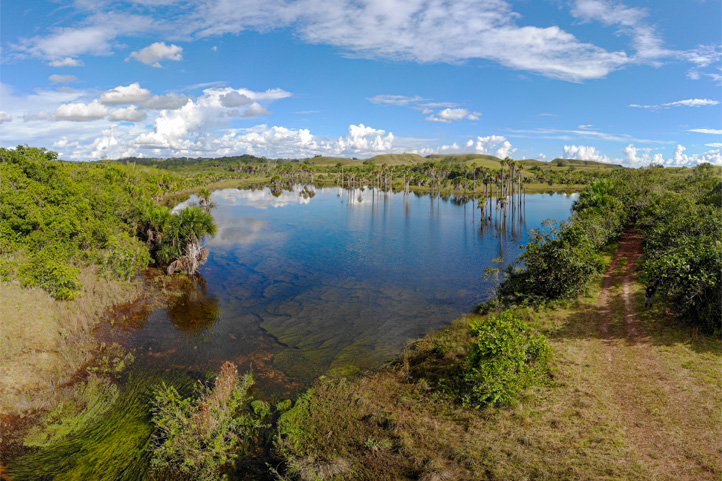
Getting to Villavicencio in Meta
- By Air: Villavicencio’s Vanguardia Airport connects the region to Bogotá and other cities in Colombia, offering a quick and convenient way to reach Meta.
- By Road: A scenic drive from Bogotá to Villavicencio is another option, showcasing beautiful landscapes along the way. The journey takes about 2-3 hours.
Villavicencio: The Gateway to Meta
As the capital of Meta, Villavicencio is more than just a gateway to the region; it’s a vibrant center of urban and cultural experiences. Below is a detailed exploration of what Villavicencio offers.
Urban Exploration and Cultural Sites
- Local Markets and Regional Cuisine:
- Delicias Llaneras: Villavicencio is famous for its local cuisine, particularly ‘Delicias Llaneras’, which includes dishes like Mamona, a type of barbecue, and other regional specialties.
- Mercado Popular: This local market is a hub of activity where visitors can immerse themselves in the daily life of the city, featuring fresh produce, regional delicacies, and crafts.
- Shopping and Local Crafts:
- Llanero Attire and Souvenirs: Reflecting the region’s cowboy culture, local shops in Villavicencio offer authentic Llanero attire, including cowboy hats, boots, and leather goods.
- Artisanal Products: The city is a great place to buy local handicrafts, from handwoven hammocks to unique jewelry and pottery crafted by local artisans.
- Cultural Centers and Museums:
- Museo del Llano: This museum provides insights into the history and culture of the Llanero people, showcasing traditional artifacts, music, and art.
- Parque Los Fundadores:
- This central park in Villavicencio is a focal point for cultural events and leisure activities, offering a green space in the heart of the city.
Discover more of what this city has to offer in our Villavicencio Colombia Travel Guide.
Natural Wonders and Outdoor Activities in Meta
Meta, with its lush landscapes and diverse ecosystems, is a paradise for nature lovers and adventure seekers. Here’s an expanded guide to the natural wonders and outdoor activities in the region, focusing on more destinations and providing detailed information about each.
Caño Cristales: The Liquid Rainbow
- Location: Situated in the Serrania de la Macarena National Park.
- Access: Reachable by a short flight from Villavicencio to La Macarena, followed by a guided hike.
- Best Time to Visit: Between July and November, when the aquatic plants give the river its vibrant colors.
- Activities: Hiking, photography, and swimming in designated areas.
Laguna de la Tablilla and Laguna Negra
- Location: Near the town of Restrepo, about an hour’s drive from Villavicencio.
- Activities: Birdwatching, nature walks, and canoeing.
- Highlights: Peaceful natural settings ideal for observing local wildlife and enjoying the serene ambiance.
Los Ocarros Biopark
- Location: A short drive from Villavicencio.
- Features: A wildlife sanctuary focusing on the conservation of local species.
- Activities: Wildlife viewing, educational tours, and interaction with some species in controlled environments.
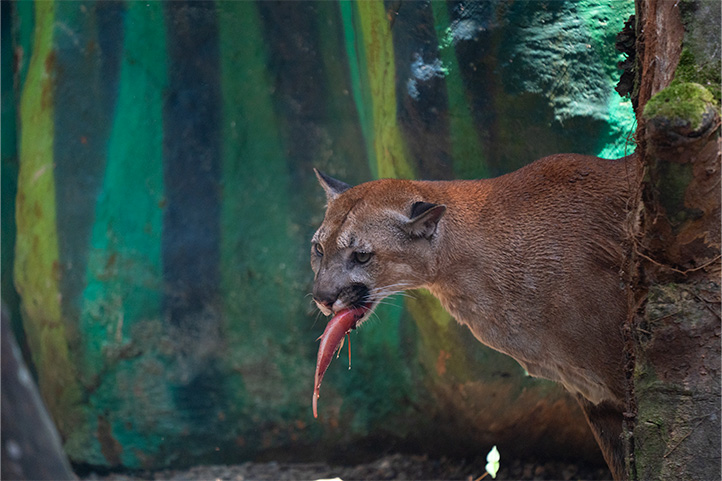
River Rafting and Canoeing
- Rivers: The Guayabero and the Ariari rivers are popular for these activities.
- Operators: Numerous tour operators in Villavicencio offer rafting and canoeing trips, suitable for various skill levels.
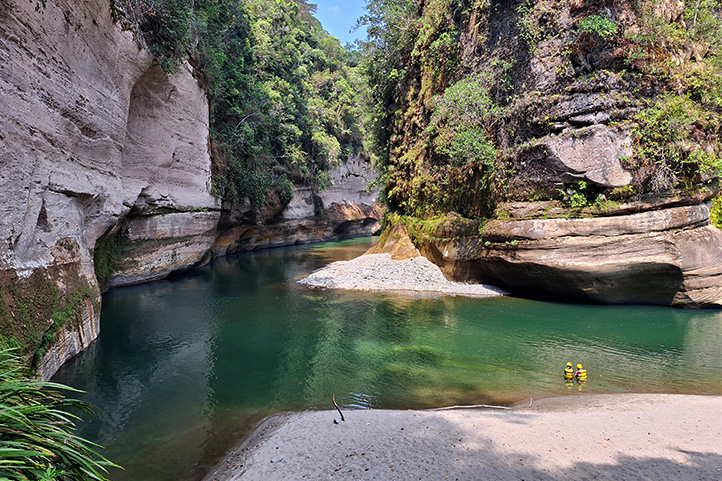
Hiking and Trekking
- Trails: The region around Villavicencio offers several trails, ranging from easy walks to challenging treks.
- Popular Areas: The foothills of the Andes and the plains near the Meta River are great for hiking enthusiasts.
Adventure Sports
- Options: Paragliding, zip-lining, and mountain biking are available in the region, offering breathtaking views and thrilling experiences.
- Locations: These activities are often centered around the more mountainous areas near Villavicencio.
Photography Tours
- Focus: These tours are designed for capturing the stunning landscapes and diverse wildlife of Meta.
- Guides: Professional guides can lead you to the best spots at the right times for optimal photography conditions.
Finca Hotel El Mururito: A Relaxing Retreat in Meta
Finca Hotel El Mururito, located in the beautiful department of Meta, Colombia, offers a peaceful and authentic experience in the heart of the Llanos region. This charming hotel provides a perfect blend of comfort, nature, and local culture. Here’s an overview of what guests can expect during their stay:
Location and Access
- Proximity to Villavicencio: El Mururito is conveniently situated near Villavicencio, making it easily accessible for visitors.
- Travel Options: Guests can reach the hotel by a short drive from Villavicencio, with the journey showcasing the scenic beauty of the Meta region.
Accommodations and Facilities
- Comfortable Lodging: The hotel offers a range of accommodations, from standard rooms to more luxurious options, all designed to provide comfort and tranquility.
- Amenities: Guests can enjoy a variety of amenities, including swimming pools, gardens, and outdoor recreational areas.
Activities and Experiences
- Local Cuisine: The hotel’s restaurant serves a variety of local dishes, offering guests a taste of the traditional flavors of the Llanos.
- Nature and Wildlife: Being in the Llanos region, guests have opportunities to observe the local flora and fauna, possibly including bird watching and nature walks.
Activities and Tourist Attractions in Arauca
Arauca, a department in eastern Colombia known for its vast plains, rich culture, and natural beauty, offers an array of activities and attractions. Here’s a structured guide to explore the best of Arauca.
Getting to Arauca
- By Air: The most convenient way to reach Arauca is to fly into Santiago Pérez Quiroz Airport in Arauca city, with flights from major cities like Bogotá.
- By Road: For those who enjoy scenic drives, traveling to Arauca from major cities like Bogotá is an option. The journey, though long, showcases the diverse landscapes of Colombia.
Arauca City: The Cultural Hub
As the capital of the department, Arauca city is not just a gateway to the region’s natural wonders but also a center for cultural experiences.
Urban Exploration and Cultural Sites
- Local Markets and Regional Cuisine:
- Llanero Cuisine: Visitors should try the local cuisine, which includes dishes like ‘carne oreada’ (sun-dried beef) and ‘casabe’ (cassava bread), reflecting the unique culinary traditions of the Llanos.
- Mercado Central: The central market in Arauca city is vibrant and bustling, offering fresh local produce and a glimpse into the everyday life of its residents.
- Shopping and Local Crafts:
- Craft Markets: Arauca is a great place to find unique local crafts, including colorful hammocks, handcrafted jewelry, and leather goods.
- Cultural Souvenirs: Traditional Llanero attire and musical instruments like the cuatro are popular souvenirs.
- Cultural Centers and Museums:
- Museo del Llano: This museum in Arauca city offers insights into the Llanero culture and history, showcasing traditional artifacts, music, and art.
Natural Beauty and Outdoor Activities
- Río Arauca and Fishing: The Arauca River is perfect for fishing, boating, and enjoying tranquil riverside views.
- Bird Watching: The region’s wetlands and grasslands are ideal for birdwatching, with a variety of species to be spotted.
- Trekking and Hiking: The diverse terrain around Arauca city offers opportunities for trekking and hiking, with trails leading through beautiful landscapes.
Festivals and Cultural Events
- Joropo Festival: Arauca hosts annual festivals celebrating Joropo music and dance, showcasing the vibrant culture of the region.
Read also our Arauca Colombia Travel Guide.
Natural Wonders and Outdoor Activities in Arauca
Arauca, a region celebrated for its natural beauty and diverse ecosystems, offers a plethora of outdoor activities and attractions for nature enthusiasts and adventure seekers. Here’s a guide to some of the best natural wonders and outdoor activities in Arauca.
Exploring the Arauca River
- Boating and Fishing: The Arauca River, a prominent feature of the landscape, is ideal for boating and fishing. It’s a peaceful way to enjoy the natural surroundings and potentially catch sight of local wildlife.
- Riverside Views: The riverbanks provide stunning views and are perfect spots for picnics and relaxation.
Wildlife and Bird Watching
- Diverse Species: Arauca’s plains and wetlands are home to a rich array of bird species, making it a paradise for birdwatchers. The region is known for its diverse avian population, including various waterfowl and tropical birds.
- Guided Tours: Local guides offer birdwatching tours, taking visitors to the best spots for observing these species in their natural habitat.
Hiking and Nature Walks
- Trails: The region offers numerous trails that traverse through its unique landscapes, from grassy plains to marshy wetlands.
- Eco-Tourism: These hikes are not only recreational but also educational, offering insights into the region’s ecology and conservation efforts.
Horseback Riding
- Llanero Experience: Horseback riding is a quintessential activity in Arauca, reflecting the Llanero (cowboy) culture. It’s a unique way to explore the vast plains and connect with the local traditions.
- Ranch Visits: Many ranches in Arauca offer horseback riding experiences, ranging from short rides to longer excursions.
Adventure Sports
- Kayaking and Canoeing: The region’s rivers and lagoons are suitable for kayaking and canoeing, offering a thrilling experience for adventure seekers.
Most Spectacular Animals in Los Llanos (Including Best Viewing Opportunities)
1. Jaguar (Panthera onca)
- Where to Find: Near water sources and in dense vegetation.
- Best Time to See: Dawn and dusk.
- Probability of Sight: Low (elusive and solitary).
2. Giant Anteater (Myrmecophaga tridactyla)
- Where to Find: Open grasslands and deciduous forests.
- Best Time to See: Early morning or late afternoon.
- Probability of Sight: Mid.
3. Capuchin Monkey (Cebinae)
- Where to Find: In the trees of tropical forests.
- Best Time to See: Throughout the day.
- Probability of Sight: High.
4. Green Iguana (Iguana iguana)
- Where to Find: Near rivers and in forest canopies.
- Best Time to See: Daytime, especially sunny mornings.
- Probability of Sight: High.
5. Capybara (Hydrochoerus hydrochaeris)
- Where to Find: Near water bodies like rivers and marshes.
- Best Time to See: Early morning and late afternoon.
- Probability of Sight: High.
6. Spectacled Caiman (Caiman crocodilus)
- Where to Find: In rivers, lakes, and wetlands.
- Best Time to See: Night (using a flashlight).
- Probability of Sight: High.
7. Anaconda (Eunectes murinus)
- Where to Find: Swamps and slow-moving streams.
- Best Time to See: During the rainy season. Also on some Hatos the cowboys find them in dry water holes during dry season.
- Probability of Sight: Low to mid.
8. Orinoco Crocodile (Crocodylus intermedius)
- Where to Find: Along the Orinoco River and its tributaries.
- Best Time to See: Dry season when they bask on riverbanks. There is a breeding center in Casanare.
- Probability of Sight: Low (endangered species).
9. Red Howler Monkey (Alouatta seniculus)
- Where to Find: In primary forests and wooded areas.
- Best Time to See: Early mornings (by their howls).
- Probability of Sight: Mid.
10. Scarlet Ibis (Eudocimus ruber)
- Where to Find: In wetlands and shallow water bodies.
- Best Time to See: Late afternoon when they return to roost.
- Probability of Sight: High.
11. Venezuelan Troupial (Icterus icterus)
- Where to Find: Open woodlands and savannas.
- Best Time to See: Morning and late afternoon.
- Probability of Sight: Mid.
12. Hoatzin (Opisthocomus hoazin)
- Where to Find: Along slow-moving rivers and swampy areas.
- Best Time to See: Early morning.
- Probability of Sight: Mid.
13. Tamandua (Tamandua tetradactyla)
- Where to Find: In both deciduous forests and grasslands.
- Best Time to See: Nighttime.
- Probability of Sight: Mid.
14. Pink River Dolphin (Inia geoffrensis)
- Where to Find: In rivers and waterways.
- Best Time to See: Dry season when rivers are calmer.
- Probability of Sight: Mid to high.
15. Orinoco Goose (Neochen jubata)
- Where to Find: Near rivers and lakes.
- Best Time to See: Morning and late afternoon.
- Probability of Sight: Mid.
16. Piranha (Serrasalmidae family)
- Where to Find: In rivers and lakes.
- Best Time to See: All day, more active during feeding times.
- Probability of Sight: High (in suitable habitats).
17. Maned Wolf (Chrysocyon brachyurus)
- Where to Find: Grasslands and scrub forests.
- Best Time to See: Dusk and dawn.
- Probability of Sight: Low.
18. Blue-and-yellow Macaw (Ara ararauna)
- Where to Find: In forested areas and near water sources.
- Best Time to See: Early morning and late afternoon.
- Probability of Sight: Mid.
19. Giant River Otter (Pteronura brasiliensis)
- Where to Find: Along rivers and lakes.
- Best Time to See: Early morning and late afternoon.
- Probability of Sight: Mid.
20. Puma (Puma concolor)
- Where to Find: In mountainous areas and dense forests.
- Best Time to See: Night or early morning.
- Probability of Sight: Low (very elusive).
21. Burrowing Owl (Athene cunicularia)
- Where to Find: Open grasslands and fields, often near their burrows.
- Best Time to See: Early morning or late afternoon.
- Probability of Sight: High, especially near their burrows.
22. Sloth (Bradypus sp.)
- Where to Find: In the canopies of tropical rainforests.
- Best Time to See: Throughout the day, but they are often motionless and hard to spot.
- Probability of Sight: Mid, requires a keen eye.
23. Armadillo (Dasypodidae family)
- Where to Find: Grasslands and forested areas, often near their burrows.
- Best Time to See: Nighttime or early morning.
- Probability of Sight: Mid.
24. Common Squirrel Monkey (Saimiri sciureus)
- Where to Find: In tropical rainforests, especially in the canopy layer.
- Best Time to See: During the day.
- Probability of Sight: High, especially in groups.
Culinary Delights of Los Llanos
- Mamona (Carne en Vara): A quintessential Llanero barbecue, where beef is slowly cooked over an open flame, known for its succulent and smoky flavor.
- Pabellón Criollo: A traditional dish comprising shredded beef, black beans, white rice, and fried plantains, offering a rich blend of textures and tastes.
- Cachama and Dorado: Popular local river fish, often grilled or stewed, and seasoned with regional herbs and spices, reflecting the area’s rich aquatic resources.
- Casabe: A crispy flatbread made from cassava (yucca), serving as a staple accompaniment to many meals in Los Llanos.
- Arepas: Versatile cornmeal patties, a staple in Colombian and Venezuelan cuisine, often filled or topped with cheese, meats, or avocado.
- Hallacas: A traditional Venezuelan dish similar to tamales, made with a corn dough stuffed with a meat mixture, wrapped in plantain leaves, and boiled.
- Llanero Cheese (Queso Llanero): A salty, artisanal cheese, often used in arepas or eaten alone, showcasing the region’s dairy production.
- Morcilla Llanera: A type of blood sausage, flavored with rice, spices, and sometimes vegetables, representing the region’s affinity for hearty, rustic foods.
- Masato: A traditional fermented drink made from rice, cinnamon, and sugar, often enjoyed as a sweet accompaniment to meals.
- Plantain Chips (Platanitos): Thinly sliced and fried plantains, serving as a crunchy and sweet snack or side dish.
Cultural Agenda in Los Llanos
January
- Festival del Retorno: Held in Aguazul, Casanare. This festival marks the return of residents who had moved away, featuring Joropo music, traditional dances, and rodeos.
February
- Festival Internacional de la Cachama: Celebrated in Puerto Gaitán, Meta. A festival dedicated to the cachama, a local fish, with culinary events, music, and cultural activities.
March
- Festival de Verano: In Villavicencio, a summer festival with concerts, sporting events, and cultural displays.
April
- Semana Santa: Holy Week is observed across Los Llanos with religious processions and cultural events.
May
- Torneo Internacional del Corrido Llanero: A music festival in Villavicencio focusing on Llanero music, showcasing local talent and traditional styles.
June
- Festival Folclórico y Reinado Nacional del Arroz: In Aguazul, Casanare. A festival celebrating rice farming with parades, beauty pageants, and cultural performances.
July
- Festival Internacional del Joropo: Held in Villavicencio, it’s one of the most significant cultural events in Los Llanos, celebrating the region’s music and dance traditions.
August
- Feria de Villavicencio: A large fair featuring cattle shows, agricultural displays, music, and dance.
September
- Festival Mundial de la Cosecha Llanera: In San Martín, Meta. This festival celebrates the Llanero culture with music, dance, and rodeos.
October
- Festival de la Cachama Negra: In Puerto López, Meta. A festival focusing on local fish and cuisine, coupled with cultural activities and music.
November
- Festival del Colono de Oro: In Puerto Carreño, Vichada. This event celebrates the settlers of the region with cultural programs, music, and traditional games.
December
- Navidad Llanera: Christmas celebrations across Los Llanos with unique local traditions, music, and festivities.
Dealing with Bugs in Los Llanos: Protection and Remedies
Understanding the Bug Situation in Los Llanos
In Los Llanos, a region celebrated for its diverse ecosystems, visitors also encounter various insects, including mosquitoes and other pests. Adequate preparation is essential for comfort and safety.
Common Pests
- Mosquitoes: These insects are prevalent in Los Llanos and can be more than just a nuisance, as they may carry diseases. Using insect repellent and wearing appropriate clothing is crucial for protection.
- Trombicula autumnalis (Chiggers): These microscopic mites can be particularly bothersome, known for causing irritating bites. They manage to infiltrate even through protective clothing like long sleeves and rubber boots.
Protection and Treatment
- Protective Clothing: Wearing light-colored, long-sleeved shirts and pants is advised. Tucking pants into socks or boots can provide additional defense against these pests.
- Insect Repellent: Applying a reliable insect repellent regularly is key. Look for products with active ingredients like DEET, picaridin, or lemon eucalyptus oil.
- Vicks Vaporub: An unconventional but effective remedy, applying Vicks Vaporub can deter chiggers. The strong scent and cooling sensation are believed to be unappealing to these mites.
- Post-Exposure Care: In case of bites, topical treatments like antihistamine creams can alleviate itching and irritation. Keeping the affected area clean to prevent infection is also important.
Environmental Considerations
- Chiggers in Cooler Climates: Chiggers, like many tropical pests, struggle to survive in cooler climates. If you travel to a cooler area like Bogota after visiting Los Llanos, you may find that any chiggers on clothing or luggage will die off due to the temperature change.
Tips for a Bug-Free Experience
- Stay Informed: Before your trip, research the current insect-related risks in Los Llanos.
- Regular Checks: After outdoor activities, check your skin and clothing for any pests.
- Seek Local Advice: Local guides and residents can offer valuable insights on effective protection methods specific to the region.
Transportation in Los Llanos
Transportation in Los Llanos, a region celebrated for its vast open spaces and stunning natural landscapes, uniquely combines modern and traditional methods, reflecting the area’s diverse geographical and cultural makeup. In urban centers like Villavicencio and Yopal, the primary modes of transport include buses, taxis, and private vehicles, facilitating easy movement within the cities. However, given the extensive nature of Los Llanos, traveling across the region often entails long drives on highways that meander through the picturesque plains and savannas.
In the more remote and rural areas, where paved roads are scarce, 4×4 vehicles become essential, especially during the rainy season, to navigate the challenging terrain. Alongside these modern methods, the enduring Llanero culture shines through in the use of horses for transport in these areas. Not only do they hold cultural significance, but horses also prove practical for moving across the unique landscape of Los Llanos.
The region’s waterways also play a crucial role in transportation. Boats are commonly used on various rivers, serving as a vital means of transport, especially in areas where road access is limited. During the rainy season, when many parts of Los Llanos become inaccessible by road, small planes are a lifeline, landing on natural airstrips often found in larger haciendas or hatos. The presence of these small airfields underscores the adaptability of transportation methods in the region.
However, it’s important to note that the complexities and variety in transportation options do contribute to higher travel costs in Los Llanos. As a result, the region is less frequented by budget travelers and is not typically considered a typical backpacker destination. Instead, Los Llanos offers a more unique and off-the-beaten-path experience, appealing to those seeking to immerse themselves in its rich landscapes and culture, supported by a diverse array of transportation modes.
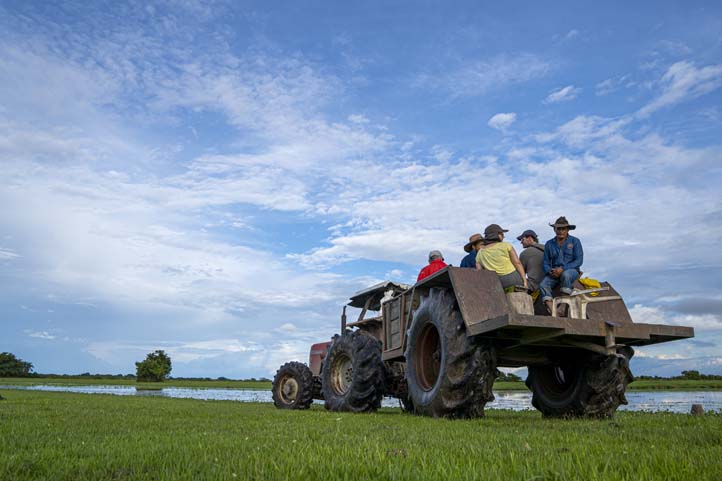
My Likes and Dislikes About Los Llanos: A Personal Perspective
What I Love About Los Llanos
- Food: The culinary offerings in Los Llanos are a gastronomic adventure. The traditional dishes, rich in flavor and heritage, offer an authentic taste of the region.
- Animals: The diverse wildlife in Los Llanos is nothing short of spectacular. From majestic jaguars to the vast herds of capybara, the animal sightings here are unparalleled.
- People: The warmth and hospitality of the people in Los Llanos are heartwarming. Their deep connection to the land and vibrant culture adds to the region’s charm.
- Landscapes: The vast, open landscapes of Los Llanos are breathtaking. The endless plains and savannas provide a sense of serenity and freedom.
- Horse Riding and Safaris: Exploring the region on horseback or through safaris offers a unique perspective of the beauty and diversity of Los Llanos. I actually learned horse riding in Los Llanos.
- Sunsets and Sunrises: The sunsets and sunrises in Los Llanos are mesmerizing. The expansive sky, painted in vivid colors, is a daily spectacle.
- Dimensions of Nature: The sheer scale and diversity of the natural environments in Los Llanos are awe-inspiring, from lush forests to sprawling wetlands.
- Growing Eco-Tourism and Habitat Restoration: The focus on eco-tourism and efforts to reestablish wildlife habitats are commendable, highlighting a commitment to conservation and sustainable tourism.
The Aspects That Concern Me
- Bugs: The presence of various insects, including mosquitoes and chiggers, can be a significant discomfort, necessitating constant protection and vigilance.
- Long Distances and Travel Times: The vastness of Los Llanos means that traveling between destinations can be time-consuming, often requiring long drives or multiple forms of transportation.
- Deforestation: Large areas of forest in Los Llanos are being cleared for various reasons, including agriculture, cattle ranching, and illegal logging. This deforestation threatens the region’s biodiversity and disrupts the habitat of many species.
- Water Pollution: Pollution of rivers and water bodies, often due to agricultural runoff or improper waste disposal, poses a threat to the aquatic ecosystems and the species that depend on them.
- Palm Oil Plantations: Expansion of palm oil plantations is one of the most significant monoculture practices in the region. While economically beneficial, these plantations can lead to loss of biodiversity, soil degradation, and reduced water quality due to the use of fertilizers and pesticides.
- Soybean Farming: Large-scale soy cultivation, often for export, can result in similar environmental issues as palm oil plantations, including deforestation and habitat loss.
- Cattle Ranching: Intensive cattle ranching leads to overgrazing, soil compaction, and can contribute to deforestation, as forests are cleared to create pasture lands.
Colombia Travel Guides
Here you will find travel guides for the most popular regions in Colombia, which we have put together during our extensive travels around the country.
- Colombia Travel Guide
- Bogota Travel Guide
- Medellin Travel Guide
- Santa Marta Travel Guide
- Cartagena Travel Guide
- La Guajira Travel Guide
- Llanos Travel Guide
- Providencia Travel Guide
- Coffee Triangle Travel Guide
- Amazonas Travel Guide
- Choco Travel Guide
- Santander Travel Guide
- Boyaca Travel Guide
- San Andres Island Travel Guide
- Cali Travel Guide
- Barranquilla Colombia Travel Guide
- Heritage Towns of Colombia Guide
- 7 Wonders of Colombia Guide
- Colombia Golf Travel Guide
- Colombia Museums Guide
Travel Guides to Colombia’s Small Towns
Here you will find travel guides for less popular destinations in Colombia. Some of these destinations are even real insider tips and not even known to the Colombians as travel destinations.
- Aguachica Colombia Travel Guide
- Arauca Colombia Travel Guide
- Armenia Colombia Travel Guide
- Barrancabermeja Colombia Travel Guide
- Bucaramanga Colombia Travel Guide
- Buenaventura Colombia Travel Guide
- Canyon Chicamocha Colombia Travel Guide
- El Carmen de Bolivar Colombia Travel Guide
- Caucasia Colombia Travel Guide
- Cucuta Colombia Travel Guide
- Florencia Colombia Travel Guide
- Ibagué Colombia travel guide
- Inirida Colombia Travel Guide
- Ipiales Colombia Travel Guide
- Magangue Colombia Travel Guide
- Manizales Colombia Travel Guide
- Mitu Colombia Travel Guide
- Mocoa Colombia Travel Guide
- Monteria Colombia Travel Guide
- Neiva Colombia Travel Guide
- Palmira Colombia Travel Guide
- Pasto Colombia Travel Guide
- Pereira Colombia Travel Guide
- Popayan Colombia Travel Guide
- Puerto Asis Colombia Travel Guide
- Puerto Carreno Colombia Travel Guide
- Quibdo Colombia Travel Guide
- Riohacha Colombia Travel Guide
- San José del Guaviare Colombia Travel Guide
- Sincelejo Colombia Travel Guide
- Sogamoso Colombia Travel Guide
- Tulua Colombia Travel Guide
- Tumaco Colombia Travel Guide
- Tunja Colombia Travel Guide
- Turbo Colombia Travel Guide
- Valledupar Colombia Travel Guide
- Villa de Leyva Colombia Travel Guide
- Villavicencio Colombia Travel Guide
- Yopal Colombia Travel Guide

